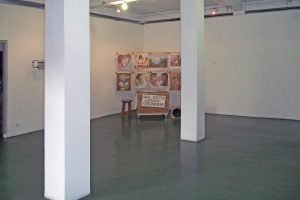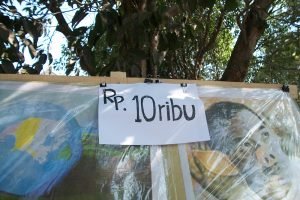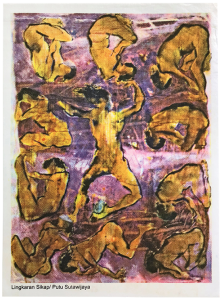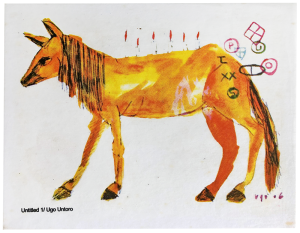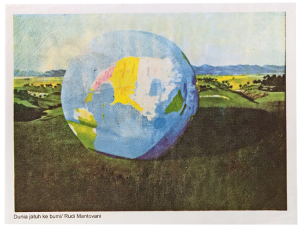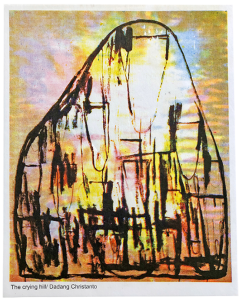
KW 2
14 October 2011
Kedai Kebun Forum
Tirtodipuran st, Mantrijeron,Yogyakarta
Indonesia
KW2 project is began from what I saw on the development of visual art in Indonesia, especially painting and graphic art, when painting has always been the number one and graphic art is below it, in relation to the market as well as object of collections. This media problem becomes a big question for me.Is it because the graphic arts can be duplicated easily, so its value is reduced compared to painting which is made only one piece? Or does the content on the work itself is the cause?
Starting from these questions, I began work on Project KW2. In this project, I made a poster with images of paintings by the most expensive contemporary artists in Indonesia, based on the data from one auction house in Paris, France. I got the images of these paintings through sites of several auction houses. I produced posters with this images using CMYK silkscreen technique. I produced 20 copies for each image. I sold it for IDR 10.000,- using sidewalk cart, on DI. Panjaitan Street.
During the process of working, I made a lot of discussion, and the basic idea of this project was developed. The issue of public /private space, authenticity, to the function of art itself, appears during those discussions. And I am still open to any possibility to keep developing the ideas, both in terms of visual as well as the content. As long as those developments accordance with the main framework of this project, namely the anxiety that I feel, and open up for possibilities to show something new.
Prihatmoko Moki
________________________________________________________________________
KW 2: My Painting As Fake As Your Love
When Jogja young artists were still poor, they were proud able to buy shoes at Outlet Biru, a shoes store which sells fake brands. Everything fakes: the wallets, shoes, watches, and I think, even the smile of the shopkeepers. This store is so famous, that you would not be considered as “cool” youngsters of south Jogja, if you did not bought shoes here. Everybody bought shoes at this store, even when they know that those shoes fake. Buying fake items, in my opinion, can be caused by not afford to buy the original, or because there are sort of “life style” demand to consume fake things. If love might be faked, so there is no problem to wear fake shoes. Your love is as fake as your shoes.
There is a generation which do not care of originality. They think that originality is weird. It is understandable, because almost all early 80’s generation is surrounded by fake things. Even when they were babies, they drank artificial breast milk (formula); then when they grew up, they were fed with fake toys made in China. Finally, when they grown up, they started to know fake shoes, t-shirts, hats, and also pirated software. From those pirated software, they started their artistic carrier. Finally, slowly but sure, the ideas of originality are erased from their collective memories. A generation weaned from falseness is the most appropriate description for Prihatmoko a.k.a. Moki’s generation, 28 years old artist.
This KW 2 art project is using falseness into different context. Moki makes posters of the most expensive paintings in the auction. He realises that even though those paintings are expensive, they are not be remembered. Those paintings can only be seen and owned by certain people in this country. Maybe only 10 -20 people who able to access directly those most expensive masterpieces. The other people only just heard the rumour about it, even the artist himself is cut from the possibility of accessing it. Those masterpieces, quoted from Sanento Yuliman, are “secluded”, just like a virgin which is secluded before the wedding. Nowadays term is “privatization”. That is why, Moki silkscreen it into poster, printed on cheap fabric, but using complicated silkscreen technique. He sold it on the roadside for 10,000 IDR each, just like pirated posters of ST12 and Sheila on Seven (Indonesian bands). In Moki’s opinion, public (also) have the rights to access those masterpieces, because mostly the ideas of those painters are taken from daily situation in Indonesia. The public have the rights to get “the cheat sheet” of Indonesian masters’.
Because the main purpose is to inform the artistic achievements to public, so the using of posters as the media is most appropriate one. People from all social classes are afford to buy it, and then pinned it on their bedroom wall. Instinctively, Moki becomes the intermediate between “lack” government cultural agencies and the governmental galleries, which have no policy to document artistic achievements of Indonesian artists through museum. Public are separated from their visual documents, which documented the society’s changing. Unconsciously, those masterpieces, out of very expensive and unreasonable price, are also social documents, which also should have social function.
Moki changes those masterpieces into posters as the answer of art privatization in Indonesia. It is an interesting “ill bred” work that is worth to be given a space. Hopefully, this small breakthrough, from curly-hair artist, is able to provoke our frigid visual art.
Agung Kurniawan
Co founder/artistic director of KKF





